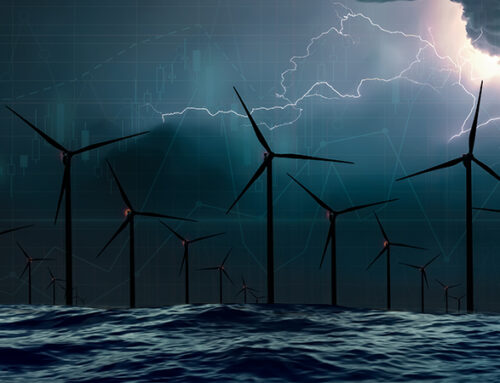Germany’s Energiewende and the resulting rapid expansion of renewable energy in Germany has been held out as the model for other nations to follow, but there are growing doubts as to its effectiveness.
As I have noted before, the decision to exit nuclear power in the aftermath of the Fukushima disaster has meant that at the same time as building large amounts of wind and solar generation, Germany’s CO2 emissions have not fallen due to the increase in the use of cheap, dirty lignite (and high prices meaning that relatively cleaner gas was pushed entirely out of the merit order, although has recently seen some recovery). At the same time, the cost to consumers has risen sharply.

In its most recent annual review, Agora Energiewende reports very mixed progress towards Germany’s climate goals:
“On the one hand, the power system became more climate friendly for the third year running: gas power plants gained back market share from coal-fired plants; the phase-out of nuclear power continued as planned; renewable energy systems delivered more electricity than ever before; electricity use fell; and support for the energy transition among Germans grew from its already high level.
On the other hand, by the end of 2016 it became clear that Germany’s total greenhouse gas emissions had risen once again; that in 2017 domestic electricity prices would exceed the 30-cent per kilowatt hour mark for the first time; and that the transition’s progress has been too slow to reach the 2020 climate and efficiency targets without major additional efforts.”
However, other problems are looming. This winter has seen prolonged periods of still, cold weather and high levels of fog, meaning that both wind and solar output has been unusually low. These weather patterns, when they arise, can persist for some time and pose a real threat to German security of supply, as outlined in this blog post by the German economist Heiner Flassbeck.

“One cannot simultaneously rely on massive amounts of wind and sunshine, dispense with nuclear power plants (for very good reasons), significantly lower the supply of fossil energy, and nevertheless tell people that electricity will definitely be available in the future.”
Building crisis in German power
A former head of RWE Innogy, Fritz Vahrenholt, has told a meeting at the House of Commons in London that the German government is refusing to acknowledge the possibility that its Energiewende policy is deeply flawed. In a report for The Global Warming Policy Foundation, he argues that Germany’s energy policy is facing a crisis for 5 reasons:
Intermittency
Wind power not only varied throughout the day but also experiences material year-on-year swings of 25-30%*. Tripling current wind capacity would still not meet even half of German power demand but would require a turbine to be installed every 2.7 km, regardless of terrain.
Grid stability
Windpark owners receive payments of €1 billion per year when they are not generating, as in periods of low demand renewable production exceeds consumption. Even these payments are not sufficient to avoid overproduction leading to dumping of excess German power on the grids of neighbouring countries, amounting to 50 TWh / year out of total annual wind production of 85 TWh*. This is leading to Germany’s neighbours installing phase shifters at the border to prevent the import of excess German power.
Despite having all this renewable power, Germany still requires significant coal generation to manage frequency control, and is also planning an extensive grid strengthening programme to transport renewable power generated in the north of the country to the demand centres in the south. Finally, the presence of so much renewable generation on the system is requiring a larger number of re-dispatching instructions from the TSO…in 2011, prior to the renewable boom there was on average one intervention per day – by 2016 this had risen to 17 interventions per day or 6000 per year at a cost of €500* million.
Market distortion
The introduction of renewable generation with feed-in-tariffs has pushed more expensive thermal plant out of the merit order – as a result, 69 plants with a combined capacity of 12 GW are running at a loss. This has led to severe supply problems, particularly in the south, so a law was rushed through the German parliament requiring permission to be sought before a plant can be closed, with a notice period of 1 year. 6 GW of capacity has been allowed to close with a further 3 GW given the status of “system relevant” meaning the power station must be operated. The owners are able to reclaim operating costs, but capital costs and profit margins are ignored. Despite this there has been a significant decrease in neither carbon dioxide emissions nor electricity consumption.
Storage and “sector coupling”
Current storage technologies are still relatively expensive and lacking in capacity. Using electric cars for storage would not provide enough capacity – even if all 40 million cars in Germany were electric, their combined storage capacity would be 400 GWh, versus the 7250 GWh* needed on “lull days” which happen several times a year. The proposed solution is “sector coupling” where in times of shortages people would have to choose which consumption to prioritise as reductions would be required.
Impact on biodiversity
Renewable generation requires a lot of land. In addition, subsidies have encouraged changes in land use for the production of biofuels. As a result, there has been a significant drop in the numbers of songbird species in Germany, and several species of birds of prey have now become endangered.
The report concludes saying that 800* citizens’ initiatives have been registered across the country in opposition to the expansion of wind generation, evidence that public support for the Energiewende is beginning to wane.
* These statistics are taken from Vahrenholt’s report. Unfortunately he does not provide attributions or any discussion of his methodology, which is a shame as it would be interesting to understand some of these numbers in more detail.
Blaming the IPCC
Vahrenholt places the blame for this policy error on the Intergovernmental Panel on Climate Change (IPCC) believing its methods have not been sufficiently scientific.
“It is driven by fear. It is driven by the fear that we will irreparably damage our climate with CO2.
Yet, new scientific findings have come out showing that CO2’s impact on the global climate has been vastly overstated by the IPCC. There has not been any significant global warming in 17 years, even though one third of the historical CO2 emissions took place during the same period and atmospheric CO2 concentrations have been rising year after year. The climate models, whose prognoses have been shown to be false, are unable to simulate the natural fluctuations of the climate.
The 60-year cyclic ocean currents provided half of the warming the globe saw between 1978 and 1998 and now that the cycles have entered their cool phase; no warming is expected until 2030. The sun, which during the second half of the 20th century saw the highest level of activity in the past 1000 years, will also contribute to cooling as it has entered an unusual period of weakness not seen in 200 years. Yes, CO2 is a climate-impacting gas, but it will not heat the mean temperature of the earth more than 1.0 – 1.5° C by the year 2100.”
That is a highly controversial claim, and one with which I have some sympathy – the charge of being unscientific is one which can be legitimately aimed at the IPCC, not least because its 2014 Climate Change Report manages to contain both of the following statements:
“The IPCC is now 95 percent certain that humans are the main cause of current global warming.”
“For the period from 1998 to 2012, 111 of the 114 available climate-model simulations show a surface warming trend larger than the observations. There is medium confidence [66-100%] that this difference between models and observations is to a substantial degree caused by natural internal climate variability, which sometimes enhances and sometimes counteracts the long-term externally forced warming trend…”
In other words the IPCC is now 95% confident that human cause global warming (which is an increase in the confidence level from the previous report) despite the fact that recent data do not support the predictions of their models.
Such statements don’t conform with accepted scientific methods, and the way in which dissenting voices are dismissed as “climate deniers” sits uneasily as it undermines open debate.
None of which is to say that consumption of fossil fuels is desirable, but it’s curious that the focus has been on CO2 and not on particulate pollution which has far more immediate negative effects on health and the environment.
Germany’s Energiewende has been presented as a heroic act to lead the fight against climate change, but the despite building a large amount of wind and solar capacity there has been no meaningful reduction in emissions. German households have seen their bills skyrocket and now there is evidence that the policy has actually been damaging to the environment by reducing biodiversity. Even if the IPCC’s conclusions are accepted, it’s difficult not to agree with Vahrenholt’s claims that the German approach to tackling the issue is not one to be followed.






This is the price you pay for allowing politicians to take over & run things.
CO2 is a very minor atmospheric gas, It has negligible effect on raising atmospheric temperature (that’s done by the sun evaporating water into clouds ) ,
The IPCCs CAGW theory puts the blame (for everything) on CO2 but they ignore basic physics, chemistry & maths, the gas laws, the laws of thermodynamics, the absorption spectra of atmospheric gasses, Stefan–Boltzmann law, Planck’s Law, Wiens law, radiative or radiatory gasses, latent heat, entropy & enthalpy…. All point away from CO2 .
I would love to be shown the particular laws of physics that allows 1 molecule in 2,500 to increase the the temperature of something hotter than it’s self….. for then we will have discovered a source of perpetual energy.
– This is a fairly well put together explanation of why CO2 cannot be the cause of any atmospheric temperature rise.
https://co2islife.wordpress.com/2017/01/30/climate-science-on-trial-co2-is-a-weak-ghg-it-has-no-dipole/
– This site http://use-due-diligence-on-climate.org/ has a lot of info on CAGW / climate change.
– More to backup what you say on the ‘unreliable’s’
http://euanmearns.com/green-mythology-adding-different-types-of-renewables-smooths-output/
Kathryn, Concerning the “pause” in global warming you would do well to get up to date with the data, something you are unlikely to do if you rely on the Global Warming Policy Forum for your information . See for instance NASA’s surface temperature series at https://data.giss.nasa.gov/gistemp/graphs/ . As you can see the planet is now 1.2 degrees above 1880 levels,. This is generally agreed to mean 1.4 degrees above pre-industrial levels. Vahrenhholt’s assertion that the CO2 released sinc the industrial revolution “will not heat the mean temperature of the earth more than 1.0 – 1.5° C by the year 2100 is now looking wholly without foundation”.
Kathryn,
You rightly point out the lack of referencing in Varenholt’s article, in particular with respect to his bar graph indicating the apparent ineffectiveness of the Energiewende. Here’s a bit of context. This graph appears to be derive from a German Govt graph of CO2 emissions, where he has, it would seem, arbitrarily cropped all data pre-2009, despite the Energiewende’s having begun back in 2001. The original is at https://www.cleanenergywire.org/factsheets/germanys-greenhouse-gas-emissions-and-climate-targets. He has chosen to start his graph in 2009 when there was a big drop in emissions corresponding to the financial crisis. The original graph tells a rather different story of an established trend of modest emissions reductions over the period of the Energiewende.